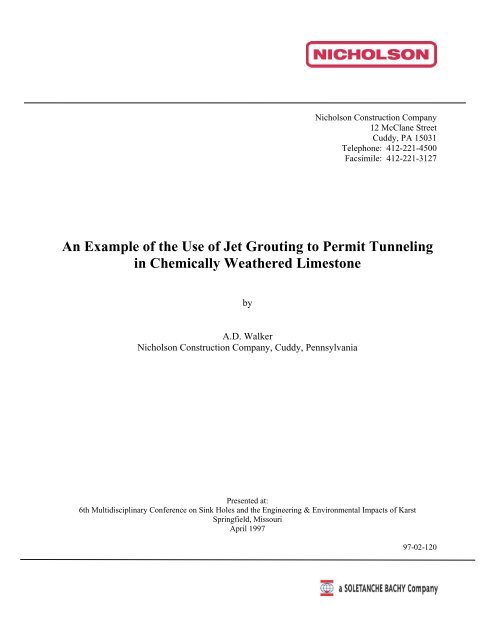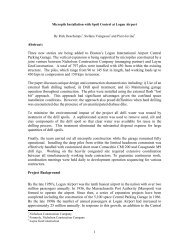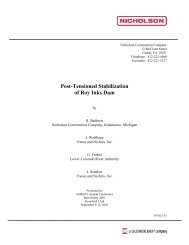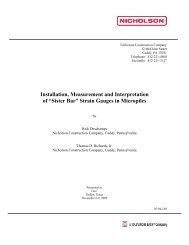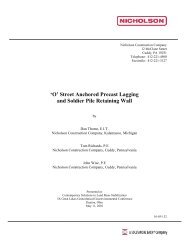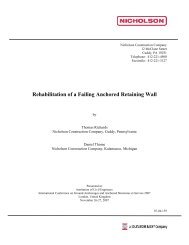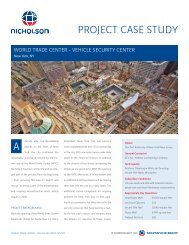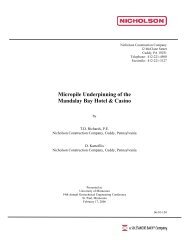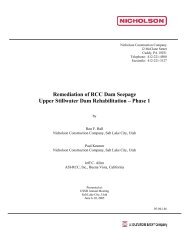An Example of the Use of Jet Grouting to Permit Tunneling in ...
An Example of the Use of Jet Grouting to Permit Tunneling in ...
An Example of the Use of Jet Grouting to Permit Tunneling in ...
Create successful ePaper yourself
Turn your PDF publications into a flip-book with our unique Google optimized e-Paper software.
Nicholson Construction Company<br />
12 McClane Street<br />
Cuddy, PA 15031<br />
Telephone: 412-221-4500<br />
Facsimile: 412-221-3127<br />
<strong>An</strong> <strong>Example</strong> <strong>of</strong> <strong>the</strong> <strong>Use</strong> <strong>of</strong> <strong>Jet</strong> <strong>Grout<strong>in</strong>g</strong> <strong>to</strong> <strong>Permit</strong> <strong>Tunnel<strong>in</strong>g</strong><br />
<strong>in</strong> Chemically Wea<strong>the</strong>red Limes<strong>to</strong>ne<br />
by<br />
A.D. Walker<br />
Nicholson Construction Company, Cuddy, Pennsylvania<br />
Presented at:<br />
6th Multidiscipl<strong>in</strong>ary Conference on S<strong>in</strong>k Holes and <strong>the</strong> Eng<strong>in</strong>eer<strong>in</strong>g & Environmental Impacts <strong>of</strong> Karst<br />
Spr<strong>in</strong>gfield, Missouri<br />
April 1997<br />
97-02-120
AN EXAMPLE OF THE USE OF JET GROUTING TO PERMIT TUNNELING IN<br />
CHEMICALLY WEATHERED LIMESTONE<br />
<strong>An</strong>drew D. Walker, Nicholson Construction Company, Cuddy, PA 15031<br />
Presented at<br />
6th Multidiscipl<strong>in</strong>ary Conference on S<strong>in</strong>kholes and <strong>the</strong><br />
Eng<strong>in</strong>eer<strong>in</strong>g & Environmental Impacts <strong>of</strong> Karst<br />
Spr<strong>in</strong>gfield, MO<br />
April, 1997<br />
ABSTRACT<br />
The paper describes <strong>the</strong> use <strong>of</strong> an <strong>in</strong>situ ground modification technique, jet grout<strong>in</strong>g, <strong>to</strong><br />
consolidate glacial and alluvial overburden overly<strong>in</strong>g highly fractured limes<strong>to</strong>ne bedrock <strong>to</strong><br />
permit m<strong>in</strong><strong>in</strong>g by a rock tunnel<strong>in</strong>g bor<strong>in</strong>g mach<strong>in</strong>e <strong>of</strong> a mixed face condition. A unique case<br />
his<strong>to</strong>ry <strong>in</strong> that special measures and modifications had <strong>to</strong> be made <strong>to</strong> <strong>the</strong> technique <strong>to</strong><br />
overcome <strong>the</strong> challenge <strong>of</strong> some very difficult site soils.<br />
INTRODUCTION<br />
At present <strong>the</strong> Upper Scio<strong>to</strong> West Intercep<strong>to</strong>r Sewer (USWIS) is under construction <strong>in</strong> <strong>the</strong><br />
northwestern section <strong>of</strong> Frankl<strong>in</strong> County, Ohio. The sewer is be<strong>in</strong>g built us<strong>in</strong>g rock tunnel<strong>in</strong>g<br />
methods with <strong>the</strong> excavated diameter <strong>of</strong> <strong>the</strong> tunnel vary<strong>in</strong>g between 9.5 and 13.5 feet.<br />
The tunnel was designed for excavation by tunnel bor<strong>in</strong>g mach<strong>in</strong>e (TMB) and a Lovat s<strong>of</strong>t<br />
ground mach<strong>in</strong>e with Boretech rock head, 129 <strong>in</strong>. <strong>in</strong> diameter was selected by <strong>the</strong> Contrac<strong>to</strong>r<br />
<strong>to</strong> drill <strong>the</strong> bedrock limes<strong>to</strong>ne and <strong>in</strong>stall 24,000 l<strong>in</strong>ear feet <strong>of</strong> pipe. In addition ten shafts are <strong>to</strong><br />
be built along <strong>the</strong> tunnel alignment.<br />
REGIONAL/SITE GEOLOGY<br />
The subsurface exploration for <strong>the</strong> project revealed that <strong>the</strong> tunnel would be built generally<br />
with<strong>in</strong> <strong>the</strong> rocks <strong>of</strong> Middle Devonian formations represent<strong>in</strong>g <strong>the</strong> Paleozoic Era. The bedrock is<br />
generally covered by glacial and alluvial soils deposited by Ill<strong>in</strong>ois and Wiscons<strong>in</strong> glaciers<br />
dur<strong>in</strong>g <strong>the</strong> Pleis<strong>to</strong>cene and by streams dur<strong>in</strong>g recent times. Importantly valleys were cut deeply<br />
<strong>in</strong><strong>to</strong> <strong>the</strong> bedrock prior <strong>to</strong> glaciation. These tributary valleys were subsequently <strong>in</strong>-filled with<br />
glacially-derived sediments along <strong>the</strong> tunnel corridor. It was <strong>the</strong>refore anticipated that limited<br />
reaches <strong>of</strong> <strong>the</strong> tunnel alignment would have a mixed face. In <strong>the</strong>se areas hand m<strong>in</strong><strong>in</strong>g was<br />
specified at a larger diameter <strong>to</strong> allow <strong>the</strong> TBM <strong>to</strong> pass through <strong>the</strong> area.<br />
There are two dist<strong>in</strong>ct aquifer systems at <strong>the</strong> site. Discont<strong>in</strong>u<strong>in</strong>g unconsolidated soils and<br />
gravels <strong>in</strong>terbedded with glacial till, primarily conf<strong>in</strong>ed <strong>to</strong> <strong>the</strong> deep buried valleys and <strong>the</strong><br />
limes<strong>to</strong>ne aquifer. In general depths <strong>to</strong> water <strong>in</strong> wells along <strong>the</strong> tunnel alignment generally<br />
range from 25 <strong>to</strong> 50 feet below grade.<br />
One such possible area was identified <strong>in</strong> <strong>the</strong> Geotechnical Design Summary Report (GDSR)<br />
when a borehole revealed bedrock at 77 ft., close <strong>to</strong> <strong>the</strong> tunnel <strong>in</strong>vert elevation, with twelve<br />
feet <strong>of</strong> gravel over <strong>the</strong> bedrock. This depth <strong>of</strong> overburden was thirty feet deeper than that found
<strong>in</strong> adjacent boreholes.<br />
It was <strong>the</strong>refore decided <strong>to</strong> undertake an additional <strong>in</strong>vestigation program <strong>in</strong> <strong>the</strong> vic<strong>in</strong>ity<br />
consist<strong>in</strong>g <strong>of</strong> six bor<strong>in</strong>gs on approximately thirty feet centers, us<strong>in</strong>g hollow stem augers with<br />
split spoon sampl<strong>in</strong>g below 50 ft. Gra<strong>in</strong> size analysis were carried out.<br />
Most zones immediately above <strong>the</strong> bedrock were classified as silty or clayey sands, or as<br />
gravels with sand and silt or clay. Gravels were described as angular <strong>to</strong> subangular. The<br />
cohesive deposits were stiff <strong>to</strong> very stiff with vary<strong>in</strong>g amounts <strong>of</strong> rock fragments and <strong>the</strong> coarse<br />
gra<strong>in</strong>ed soils were dense.<br />
The zone where gravel was found previously at great depth was re<strong>in</strong>terpreted as a localized<br />
feature, a crevice, possibly a solution feature <strong>in</strong> <strong>the</strong> limes<strong>to</strong>ne bedrock which had been filled<br />
with detrital material dur<strong>in</strong>g subsequent geological processes, as opposed <strong>to</strong> a buried valley<br />
filled with alluvial material. <strong>An</strong> additional bor<strong>in</strong>g at <strong>the</strong> same location did not encounter rock at<br />
8 ft. below tunnel <strong>in</strong>vert while bor<strong>in</strong>gs 10 ft. and 20 ft. away <strong>in</strong> plan identified rock above <strong>the</strong><br />
tunnel crown.<br />
Fur<strong>the</strong>rmore, <strong>the</strong> gravel was angular <strong>to</strong> subangular, suggest<strong>in</strong>g this was not from a typical<br />
alluvial streambed where more rounded gravel would be expected.<br />
The new rock pr<strong>of</strong>ile <strong>in</strong>dicated at least 180 ft. <strong>of</strong> mixed face m<strong>in</strong><strong>in</strong>g which <strong>the</strong> TBM could not<br />
m<strong>in</strong>e unless modified <strong>to</strong> a Earth Pressure Balance (EPB) mode. The o<strong>the</strong>r alternate, as<br />
envisaged by <strong>the</strong> Contract, was <strong>to</strong> hand m<strong>in</strong>e at a larger diameter <strong>to</strong> allow <strong>the</strong> TBM <strong>to</strong> pass.<br />
This was a slow, high risk operation and o<strong>the</strong>r options were sought.<br />
The use <strong>of</strong> permeation grout<strong>in</strong>g techniques where cement-based or chemical grouts are<br />
<strong>in</strong>jected under controlled pressure <strong>in</strong><strong>to</strong> <strong>the</strong> soil pores <strong>to</strong> provide consolidation was discounted<br />
given <strong>the</strong> f<strong>in</strong>e gra<strong>in</strong>ed nature <strong>of</strong> <strong>the</strong> soils immediately above bedrock. With f<strong>in</strong>es contents <strong>in</strong><br />
general over 20 percent this placed <strong>the</strong>m <strong>in</strong> <strong>the</strong> marg<strong>in</strong>al <strong>to</strong> ungroutable category.<br />
Nicholson Construction Company <strong>of</strong> Bridgeville, PA were contacted, as a specialist<br />
Geotechnical Contrac<strong>to</strong>r, for advice and proposed <strong>the</strong> use <strong>of</strong> jet grout<strong>in</strong>g <strong>to</strong> consolidate <strong>the</strong><br />
overburden deposits <strong>to</strong> sufficient strength <strong>to</strong> allow <strong>the</strong> TBM <strong>to</strong> m<strong>in</strong>e through <strong>the</strong> area. This<br />
technique is not dependent on <strong>the</strong> pore size <strong>of</strong> <strong>the</strong> deposits as it breaks down <strong>the</strong> soil fabric<br />
and mixes <strong>the</strong> soil and grout <strong>in</strong>situ.<br />
THE JET GROUT TECHNIQUE<br />
The A.S.C.E. (American Society <strong>of</strong> Civil Eng<strong>in</strong>eers) has def<strong>in</strong>ed jet grout<strong>in</strong>g as a "technique<br />
utiliz<strong>in</strong>g a special drill bit with horizontal and vertical high speed water jets <strong>to</strong> excavate alluvial<br />
soils and produce hard impervious columns by pump<strong>in</strong>g grout through <strong>the</strong> horizontal nozzles<br />
that jets and mixes with foundation material as <strong>the</strong> drill bit is withdrawn".<br />
While jet grout<strong>in</strong>g is not familiar <strong>to</strong> many practic<strong>in</strong>g Geotechnical Eng<strong>in</strong>eers and impressive list<br />
<strong>of</strong> successfully completed projects now exists <strong>in</strong> <strong>the</strong> U.S.A., go<strong>in</strong>g back as far as 1986<br />
(<strong>An</strong>dromalos and Pettit, 1986) with many impressive recent case his<strong>to</strong>ries (Bruce and<br />
Pellegr<strong>in</strong>o). It is <strong>the</strong> <strong>in</strong>tent that this paper adds <strong>to</strong> <strong>the</strong> body <strong>of</strong> technical <strong>in</strong>formation currently<br />
available on <strong>the</strong> technique, as a case his<strong>to</strong>ry <strong>in</strong> very difficult soils never previously<br />
documented.
At present <strong>the</strong>re exists three basic jet grout methods used by Nicholson Construction, all<br />
developed by <strong>the</strong> sister company Giovanni Rodio & C. <strong>of</strong> Milan, Italy.<br />
Rod<strong>in</strong>jet 1 - S<strong>in</strong>gle Fluid System : The fluid is grout which <strong>in</strong>jected at high nozzles pressures<br />
(>20mpa) cuts and mixes <strong>the</strong> soil <strong>in</strong> situ.<br />
Rod<strong>in</strong>jet 2 - Double-Fluid System : This system utilizes on air shroud around <strong>the</strong> grout <strong>to</strong><br />
produce greater cutt<strong>in</strong>g efficiency and <strong>to</strong> improve spoil removal.<br />
Rod<strong>in</strong>jet 3 - Triple-Fluid System : In this system, which is <strong>the</strong> most complex, <strong>the</strong> cutt<strong>in</strong>g<br />
medium is a high pressure water jet with an air shroud with a low pressure separate grout<br />
nozzle for replac<strong>in</strong>g <strong>the</strong> cut material.<br />
For all systems <strong>the</strong> sequence <strong>of</strong> operation is very similar <strong>in</strong> that:<br />
a) A drill str<strong>in</strong>g is advanced <strong>to</strong> <strong>the</strong> desired depth by rotary drill<strong>in</strong>g with <strong>the</strong><br />
jett<strong>in</strong>g <strong>to</strong>ol (moni<strong>to</strong>r) fitted <strong>to</strong> <strong>the</strong> end, us<strong>in</strong>g direct circulation <strong>of</strong> water or<br />
ben<strong>to</strong>nite mud at low pressure.<br />
b) Grout jett<strong>in</strong>g through radial nozzles located on <strong>the</strong> moni<strong>to</strong>r as <strong>the</strong> <strong>to</strong>ol is<br />
rotated and extracted. In order <strong>to</strong> prevent high pressurization <strong>of</strong> <strong>the</strong> ground <strong>the</strong><br />
annulus must be ma<strong>in</strong>ta<strong>in</strong>ed at all times with excess spoil and grout return<strong>in</strong>g<br />
<strong>to</strong> <strong>the</strong> surface, thus ensur<strong>in</strong>g pressure release.<br />
The size and properties <strong>of</strong> <strong>the</strong> jet grout columns formed depends upon <strong>the</strong> nozzle geometry, lift<br />
rate and rotational speed <strong>of</strong> <strong>the</strong> moni<strong>to</strong>r, <strong>the</strong> type, density and strength <strong>of</strong> <strong>the</strong> soil, and <strong>the</strong><br />
grout mix.<br />
TEST PROGRAM<br />
In order <strong>to</strong> determ<strong>in</strong>e <strong>the</strong> most appropriate jet grout parameter <strong>to</strong> achieve <strong>the</strong> ground<br />
improvement required it is always advisable <strong>to</strong> construct test columns and, wherever possible,<br />
<strong>to</strong> excavate, visually exam<strong>in</strong>e and survey <strong>the</strong> result<strong>in</strong>g product.<br />
To permit satisfac<strong>to</strong>ry tunnel<strong>in</strong>g it was established that a target compressive strength after<br />
treatment <strong>of</strong> 6N/mm 2 (800 psi) was needed for <strong>the</strong> overburden soils and that <strong>the</strong> block <strong>of</strong><br />
consolidated soil would extend six feet above <strong>the</strong> crown and six feet below <strong>the</strong> <strong>in</strong>vert, or <strong>to</strong><br />
rock, with a width <strong>of</strong> 6.9 m and a length <strong>of</strong> 92 m. (See Figure 1.) The jet grout was not required<br />
<strong>to</strong> provide water cut<strong>of</strong>f as <strong>the</strong> flows expected from perched water <strong>in</strong> <strong>the</strong> overburden were low.<br />
Figure 1: Design Section - <strong>Jet</strong> Grout
S<strong>in</strong>ce it was impractical <strong>to</strong> excavate test columns <strong>in</strong> <strong>the</strong> production area due <strong>to</strong> <strong>the</strong> overburden<br />
depth <strong>the</strong> test section was located adjacent <strong>to</strong> shaft #7 where rock was at 6 m (20 ft.) and <strong>the</strong><br />
soils were stiff <strong>to</strong> very stiff silts with some gravel and medium dense f<strong>in</strong>e <strong>to</strong> coarse sand,<br />
typical <strong>of</strong> <strong>the</strong> soils anticipated for <strong>the</strong> production phase.<br />
A <strong>to</strong>tal <strong>of</strong> 4 test columns were built us<strong>in</strong>g <strong>the</strong> RJ2 System and subsequently excavated and<br />
cores taken <strong>of</strong> <strong>the</strong> jetted material. All columns formed were over 1.8 m (6 ft.) <strong>in</strong> diameter with<br />
<strong>the</strong> more cementitious grout produc<strong>in</strong>g <strong>the</strong> higher strengths. Test results are provided <strong>in</strong> Figure<br />
2.<br />
Column<br />
No.<br />
Pressure<br />
Pressure<br />
Withdrawal<br />
Grout<br />
c/w<br />
Ratio<br />
Diameter<br />
U.C.S.<br />
Age<br />
Cement<br />
Air<br />
Rate<br />
Flow<br />
(m)<br />
(N/mm 2 )<br />
(dys)<br />
(bars)<br />
(bars)<br />
(sec/step)<br />
(l/m<strong>in</strong>.)<br />
A1 400 11 8.9 10 0.93 1.5 3.2<br />
5.6<br />
A2 400 11 8.9 10 1.10 1.5 4.7<br />
4.0<br />
B1 400 11 12.9 10 1.10 1.8 3.2<br />
5.2<br />
B2 400 11 12.9 10 1.10 1.8 4.2<br />
7.3<br />
7<br />
28<br />
7<br />
28<br />
7<br />
28<br />
7<br />
28<br />
Figure 2: Test Program Results<br />
The parameters adopted were as for <strong>the</strong> ‘B’ series <strong>of</strong> columns allow<strong>in</strong>g <strong>the</strong> use <strong>of</strong> a grid on 1.5<br />
m c/c with a <strong>to</strong>tal <strong>of</strong> 258 columns <strong>to</strong> provide <strong>the</strong> block dimensions required. (See Figure 3) It<br />
was anticipated that <strong>the</strong> hole depths would vary from 19.5 m (64 ft.) <strong>to</strong> 26 m (87 ft.).
Figure 3: <strong>Jet</strong> Grout Plan<br />
CONSTRUCTION<br />
Even though <strong>the</strong> site was restricted with<strong>in</strong> <strong>the</strong> tunnel right <strong>of</strong> way good progress was made<br />
with an equipment spread consist<strong>in</strong>g <strong>of</strong> a Casagrande C8 <strong>Jet</strong> Grout rig, a Rodio IM20 Batch<br />
Plant and a GeoAstra <strong>Jet</strong> Grout Pump.<br />
Of some concern was <strong>the</strong> very variable depth <strong>to</strong> rock experienced with depths vary<strong>in</strong>g across<br />
<strong>the</strong> block over 6.1 m (20 ft.) and with major differences from column <strong>to</strong> column. This suggested<br />
possible extensive vertical fissures and cracks <strong>in</strong> <strong>the</strong> rock which <strong>the</strong> drill str<strong>in</strong>g was follow<strong>in</strong>g. It<br />
was clear though that two separate, district valley features did exist. (See Figure 4.)<br />
Figure 4: Actual Rock Elevations
Unfortunately when <strong>the</strong> <strong>in</strong>itial cored holes were sunk <strong>to</strong><br />
retrieve samples <strong>of</strong> jet grouted soil areas <strong>of</strong> untreated<br />
clean gravels were found with<strong>in</strong> <strong>the</strong> cores. This <strong>in</strong>dicated<br />
loss <strong>of</strong> grout dur<strong>in</strong>g jet grout operations. Work was<br />
suspended until <strong>the</strong> cause <strong>of</strong> <strong>the</strong> problem was identified.<br />
Three wells were sunk adjacent <strong>to</strong> <strong>the</strong> block with <strong>the</strong> well<br />
screens set <strong>in</strong> <strong>the</strong> suspected high permeability material. A<br />
KVA Model 40 Horizontal Meter was used <strong>to</strong> evaluate<br />
static groundwater velocities which were found <strong>to</strong> be low<br />
at an average <strong>of</strong> 1.7 ft. per day, and were consistent with<br />
static groundwater gradient data.<br />
high permeability.<br />
Interest<strong>in</strong>gly when a pump well <strong>in</strong> <strong>the</strong> bedrock which was<br />
located 45 m from <strong>the</strong> nearest moni<strong>to</strong>r<strong>in</strong>g well was<br />
activated 5 ft. <strong>of</strong> drawdown was observed after 45 m<strong>in</strong>s.<br />
and flow velocities were higher than could be measured<br />
by <strong>the</strong> <strong>in</strong>strument (> 50 feet per day). Fur<strong>the</strong>rmore<br />
drawdown was also observed <strong>in</strong> <strong>the</strong> o<strong>the</strong>r wells confirm<strong>in</strong>g<br />
that <strong>the</strong> gravel layers were hydraulically connected and <strong>of</strong><br />
Subsequent cor<strong>in</strong>g also revealed <strong>the</strong> presence <strong>of</strong> some small (> 150 mm thick) solution<br />
cavities with<strong>in</strong> a few feet <strong>of</strong> <strong>the</strong> <strong>to</strong>p <strong>of</strong> rock.<br />
It was decided <strong>to</strong> attack <strong>the</strong> problem <strong>in</strong> two ways. Firstly, <strong>to</strong> test a tremie grout method where a<br />
stable cement grout is <strong>in</strong>jected under pressure with<strong>in</strong> ungrouted columns from <strong>the</strong> rock/soil<br />
<strong>in</strong>terface upwards as a drill cas<strong>in</strong>g is slowly withdrawn. This could provide two benefits, grout<br />
solid <strong>the</strong> open gravels and seal possible shallow solution cavities.<br />
Secondly <strong>to</strong> look <strong>to</strong> use additives <strong>to</strong> accelerate <strong>the</strong> <strong>in</strong>itial set <strong>of</strong> <strong>the</strong> grout dur<strong>in</strong>g jett<strong>in</strong>g and <strong>to</strong><br />
vary <strong>the</strong> jet grout parameters previously employed.<br />
A <strong>to</strong>tal <strong>of</strong> sixteen tremie grout holes were carried out with<strong>in</strong> <strong>the</strong> deeper valley feature us<strong>in</strong>g<br />
cement ben<strong>to</strong>nite grout mixes (Figure 7).
Mix<br />
Water<br />
Cement<br />
Ben<strong>to</strong>nite<br />
Marsh Cone<br />
Specific Gravity<br />
Bleed<br />
(l)<br />
(Kg)<br />
(Kg)<br />
(sec)<br />
with heterogeneous overburden deposits rang<strong>in</strong>g from very stiff clays <strong>to</strong> clean gravels<br />
overly<strong>in</strong>g a highly fractured limes<strong>to</strong>ne bedrock that had experienced <strong>the</strong> dissolv<strong>in</strong>g action <strong>of</strong><br />
groundwater <strong>to</strong> open and <strong>in</strong>fill <strong>the</strong>se crevices and <strong>to</strong> form solution cavities.<br />
The jet grout technique has proven flexible <strong>in</strong> meet<strong>in</strong>g <strong>the</strong>se unique demands and <strong>to</strong> provide<br />
ground improvement <strong>to</strong> enable a rock tunnel<strong>in</strong>g mach<strong>in</strong>e <strong>to</strong> be used, thus remov<strong>in</strong>g <strong>the</strong> risk <strong>of</strong><br />
hand m<strong>in</strong><strong>in</strong>g and reduc<strong>in</strong>g <strong>the</strong> overall cost <strong>of</strong> <strong>the</strong> project for <strong>the</strong> City <strong>of</strong> Columbus.<br />
REFERENCES<br />
<strong>An</strong>dromalos, K.B., and Pettit, P.J., 1986, <strong>Jet</strong> <strong>Grout<strong>in</strong>g</strong>: Snail’s Pace <strong>of</strong> Adoption: Civil<br />
Eng<strong>in</strong>eer<strong>in</strong>g, A.S.C.E., December, 40-43 pp.<br />
Bruce, D.A., and Pellegr<strong>in</strong>o, G., 1995, <strong>Jet</strong> <strong>Grout<strong>in</strong>g</strong> for Solv<strong>in</strong>g <strong>Tunnel<strong>in</strong>g</strong> problems <strong>in</strong> S<strong>of</strong>t<br />
Clays. International Conference on Soil Mechanics, Tokyo, Japan, 1996.<br />
This article was published <strong>in</strong>:<br />
Beck, B.F. and Stephenson, J.B. (eds.), 1997, The Eng<strong>in</strong>eer<strong>in</strong>g Geology and Hydrogeology <strong>of</strong><br />
Karst Terranes - Proceed<strong>in</strong>gs <strong>of</strong> <strong>the</strong> Sixth Multidiscipl<strong>in</strong>ary Conference on S<strong>in</strong>kholes and <strong>the</strong><br />
Eng<strong>in</strong>eer<strong>in</strong>g and Environmental Impacts <strong>of</strong> Karst, Spr<strong>in</strong>gfield, MO: Rotterdam, Ne<strong>the</strong>rlands,<br />
A.A. Balkema, p. 381-388.


